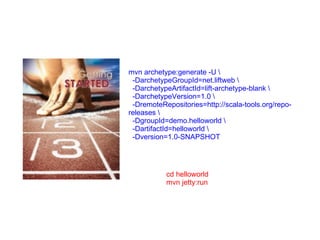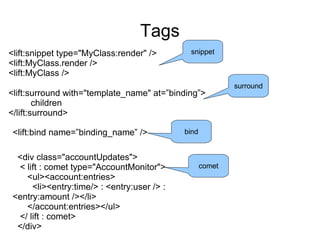Ad
Overview Of Lift Framework
- 1. Overview of Lift Web Framework Vikas Hazrati www.xebiaindia.com
- 2. Today There is a Wide Choice of Web Frameworks
- 3. As Developers It is Hard to Make a Choice
- 4. Every Framework Has its Own Set of Pitfalls
- 5. But Quick Development is Still an Option
- 7. Why is Lift Better? Convention over configuration Clean separation of presentation content and logic Leverage the Responsive Scala programming language community Concise code increases Powerful AJAX & Comet productivity Support Highly Scalable
- 8. mvn archetype:generate -U -DarchetypeGroupId=net.liftweb -DarchetypeArtifactId=lift-archetype-blank -DarchetypeVersion=1.0 -DremoteRepositories=http://scala-tools.org/repo- releases -DgroupId=demo.helloworld -DartifactId=helloworld -Dversion=1.0-SNAPSHOT cd helloworld mvn jetty:run
- 10. index.html <lift:surround with="default" at="content"> <h2>Welcome to your project!</h2> <p><lift:helloWorld.howdy /></p> </lift:surround> class HelloWorld { def howdy = <span>Welcome to helloworld at {new _root_.java.util.Date}</span> }
- 11. default.html <html xmlns="http://www.w3.org/1999/xhtml" xmlns:lift="http://liftweb.net/"> <head> <meta http-equiv="content-type" content="text/html; charset=UTF- 8" /> <meta name="description" content="" /> <meta name="keywords" content="" /> <title>demo.helloworld:helloworld:1.0-SNAPSHOT</title> <script id="jquery" src="/classpath/jquery.js" type="text/javascript"></script> </head> <body> <lift:bind name="content" /> <lift:Menu.builder /> <lift:msgs/> </body> </html>
- 12. Boot Class package bootstrap.liftweb import _root_.net.liftweb.util._ import _root_.net.liftweb.http._ import _root_.net.liftweb.sitemap._ import _root_.net.liftweb.sitemap.Loc._ import Helpers._ /** * A class that's instantiated early and run. It allows the application * to modify lift's environment */ class Boot { def boot { // where to search snippet LiftRules.addToPackages("demo.helloworld") // Build SiteMap val entries = Menu(Loc("Home", List("index"), "Home")) :: Nil LiftRules.setSiteMap(SiteMap(entries:_*)) } }
- 13. Lift Entry Point <?xml version="1.0" encoding="ISO-8859-1"?> <!DOCTYPE web-app PUBLIC "-//Sun Microsystems, Inc.//DTD Web Application 2.3//EN" "http://java.sun.com/dtd/web-app_2_3.dtd"> <web-app> <filter> <filter-name>LiftFilter</filter-name> <display-name>Lift Filter</display-name> <description>The Filter that intercepts lift calls</description> <filter-class>net.liftweb.http.LiftFilter</filter-class> </filter> <filter-mapping> <filter-name>LiftFilter</filter-name> <url-pattern>/*</url-pattern> </filter-mapping> </web-app>
- 14. Lift’s Main Objects net.liftweb.http.S net.liftweb.http.SHtml net.liftweb.http.LiftRules
- 15. Template Snippets Boot Adding AJAX class Spice Model
- 16. Model
- 17. Maps to rdbms class ToDo extends LongKeyedMapper[ToDo] with IdPK { def getSingleton = ToDo object done extends MappedBoolean(this) object owner extends MappedLongForeignKey(this, User) object priority extends MappedInt(this) { override def defaultValue = 5 } object desc extends MappedPoliteString(this, 128) } object ToDo extends ToDo with LongKeyedMetaMapper[ToDo] Provides meta functionality Like finders etc
- 18. Persistence
- 19. Mapper and Record Frameworks Per instance Mapper Global MetaMapper Record Per field MappedField <project ...> ... <dependencies> ... <dependency> <groupId>net.liftweb</groupId> <artifactId>lift-mapper</artifactId> <version>1.0</version> <!-- or 1.1-SNAPSHOT, etc --> </dependency> </dependencies> ... </project>
- 20. Database Connection class Boot { def boot { ... DB.defineConnectionManager(DefaultConnectionIdentifier, DBVendor) Schemifier.schemify(true, Log.infoF _, User, ToDo) import _root_.net.liftweb.mapper._ import _root_.java.sql._ object DBVendor extends ConnectionManager { // Force load the driver Class.forName("org.postgresql.Driver") // define methods def newConnection(name : ConnectionIdentifier) = { try { Full(DriverManager.getConnection( "jdbc:postgresql://localhost/mydatabase", "root", "secret")) } catch { case e : Exception => e.printStackTrace; Empty } } def releaseConnection (conn : Connection) { conn.close }
- 21. import _root_.java.math.MathContext class Expense extends LongKeyedMapper[Expense] with IdPK { def getSingleton = Expense object dateOf extends MappedDateTime(this) object description extends MappedString(this,100) object amount extends MappedDecimal(this, MathContext.DECIMAL64, 2) object account extends MappedLongForeignKey(this, Account) } create save delete count countByInsecureSQL findAll findAllByInsecureSQL findAllByPreparedStatement findAllFields
- 22. Templates
- 23. Templates Lift tag <lift:surround with="default" at="content"> <head><title>Hello!</title></head> <lift:Hello.world /> </lift:surround> Snippet
- 24. Views class ExpenseView extends LiftView { override def dispatch = { case "enumerate" => doEnumerate _ } def doEnumerate () : NodeSeq = { ... <lift:surround with="default" at="content"> { expenseItems.toTable } </lift:surround> } }
- 25. Tags <lift:snippet type="MyClass:render" /> snippet <lift:MyClass.render /> <lift:MyClass /> surround <lift:surround with="template_name" at=”binding”> children </lift:surround> <lift:bind name=”binding_name” /> bind <div class="accountUpdates"> < lift : comet type="AccountMonitor"> comet <ul><account:entries> <li><entry:time/> : <entry:user /> : <entry:amount /></li> </account:entries></ul> </ lift : comet> </div>
- 26. Snippets View Logic
- 27. <lift:Util.out> Lift tags Please Log In <b>Dude</b> </lift:Util.out> Corresponding Snippet package com.liftworkshop.snippet code import scala.xml.{NodeSeq} import com.liftworkshop._ import model._ class Util { def in(html: NodeSeq) = if (User.loggedIn_?) html else NodeSeq.Empty def out(html: NodeSeq) = if (!User.loggedIn_?) html else NodeSeq.Empty }
- 29. Snippets class Ledger { def balance (content : NodeSeq) : NodeSeq = Text(currentLedger.formattedBalance) } class Ledger { def balance (content : NodeSeq) : NodeSeq = <p>{currentLedger.formattedBalance} as of <lift:Util.time /></p> } <lift:Ledger.balance> <ledger:balance/> as of <ledger:time /> </lift:Ledger.balance> class Ledger { def balance (content : NodeSeq ) : NodeSeq = bind ("ledger", content, "balance" -> Text(currentLedger.formattedBalance), "time" -> Text((new java.util.Date).toString)) }
- 30. Snippets are Stateless Cookies SessionVar RequestVar StatefulSnippet Subclass
- 31. Form Processing Post/Get JSON AJAX
- 32. Form Processing <html> ... <lift:Show.myForm form="POST"> <tr> <td>Name</td> <td><f:name><input type="text"/></f:name></td> </tr> <tr> <td>Birthyear</td> <td><f:year> <select><option>2007</option></select> </f:year></td> </tr> <tr> <td> </td> <td><input type="submit" value="Add"/></td> </tr> </lift:Show.myForm> </html>
- 33. Form Processing class Show { def myForm(xhtml: NodeSeq) = { var name = "" def handleYear(year: String) { ... the form’s been submitted... do something } bind("f", xhtml, "name" -> text(name, name = _), "year" -> select((1900 to 2007). toList.map(_.toString). reverse.map(v => (v, v)), Empty, handleYear _)) } }
- 34. Goodies ProtoUser and MegaProtoUser class User extends ProtoUser[User] { override def shortName = firstName.is override lastNameDisplayName = "surname" }
- 35. AJAX and Comet
- 36. JavaScript import JsCmds._ import JE._ var myName = "" bind(... "name" -> text(myName, myName = _, "id" -> "myName"), "submit" -> submit("Save", ..., "onclick" -> JsIf(JsEq(ValById("myName"), ""), Alert("You must provide a name") & JsReturn(false)) ) ) import net.liftweb.http.js.yui.YUIArtifacts class Boot { def boot = { ... LiftRules.jsArtifacts = YUIArtifacts ... }
- 37. AJAX and Comet
- 38. AJAX and Comet
- 39. Comet Based on Scala Actors
- 40. AJAX <lift:TD.list all_id="all_todos"> <div id="all_todos"> <div>Exclude done <todo:exclude/></div> <ul> <todo:list> <li> <todo:check><input type="checkbox"/></todo:check> <todo:priority> <select><option>1</option></select> </todo:priority> <todo:desc>To Do</todo:desc> </li> </todo:list> </ul> </div> </lift:TD.list>
- 41. def list(html: NodeSeq) = { val id = S.attr("all_id").open_! def inner(): NodeSeq = { def reDraw() = SetHtml(id, inner()) bind("todo", html, "exclude" -> ajaxCheckbox(QueryNotDone, v => {QueryNotDone(v); reDraw}), "list" -> doList(reDraw) _) } inner() private def doList(reDraw: () => JsCmd)(html: NodeSeq): } NodeSeq = toShow. flatMap(td => bind("todo", html, "check" -> ajaxCheckbox(td.done, v => {td.done(v).save; reDraw()}), "priority" -> ajaxSelect(ToDo.priorityList, Full(td.priority.toString), v => {td.priority(v.toInt).save; reDraw()}), "desc" -> desc(td, reDraw) )) private def desc(td: ToDo, reDraw: () => JsCmd) = swappable(<span>{td.desc}</span>, <span>{ajaxText(td.desc, v => {td.desc(v).save; reDraw()})} </span>)
- 42. Comet <lift:surround with="default" at="content"> <lift:comet type="Clock" name="Other"> Current Time: <clk:time>Missing Clock</clk:time> </lift:comet> </lift:surround> class Clock extends CometActor { override def defaultPrefix = Full("clk") def render = bind("time" -> timeSpan) def timeSpan = (<span id="time">{timeNow}</span>) // schedule a ping every 10 seconds so we redraw ActorPing.schedule(this, Tick, 10000L) override def lowPriority : PartialFunction[Any, Unit] = { case Tick => { println("Got tick " + new Date()); partialUpdate(SetHtml("time", Text(timeNow.toString))) // schedule an update in 10 seconds ActorPing.schedule(this, Tick, 10000L) } } } case object Tick
- 44. Rails v/s Lift For single request processing, the lift code, running inside Tomcat, ran 4 times faster than the Rails code running inside Mongrel. However, the CPU utilization was less than 5% in the lift version, where it was 100% of 1 CPU (on a dual core machine) for the Rails version. For multiple simultaneous requests being made from multiple machines, we're seeing better than 20x performance of the lift code versus the Rails code with 5 Mongrel instances. Once again, the lift code is not using very much CPU and the Rails code is pegging both CPUs. http://lambda-the-ultimate.org/node/2147
- 45. Lots of Choices

















![Maps to rdbms
class ToDo extends LongKeyedMapper[ToDo] with IdPK {
def getSingleton = ToDo
object done extends MappedBoolean(this)
object owner extends MappedLongForeignKey(this, User)
object priority extends MappedInt(this) {
override def defaultValue = 5
}
object desc extends MappedPoliteString(this, 128)
}
object ToDo extends ToDo with LongKeyedMetaMapper[ToDo]
Provides meta functionality
Like finders etc](https://image.slidesharecdn.com/overviewofliftframework-091214033639-phpapp02/85/Overview-Of-Lift-Framework-17-320.jpg)



![import _root_.java.math.MathContext
class Expense extends LongKeyedMapper[Expense] with IdPK {
def getSingleton = Expense
object dateOf extends MappedDateTime(this)
object description extends MappedString(this,100)
object amount extends MappedDecimal(this, MathContext.DECIMAL64, 2)
object account extends MappedLongForeignKey(this, Account)
}
create save delete count countByInsecureSQL
findAll findAllByInsecureSQL findAllByPreparedStatement
findAllFields](https://image.slidesharecdn.com/overviewofliftframework-091214033639-phpapp02/85/Overview-Of-Lift-Framework-21-320.jpg)












![Goodies
ProtoUser and MegaProtoUser
class User extends ProtoUser[User] {
override def shortName = firstName.is
override lastNameDisplayName = "surname"
}](https://image.slidesharecdn.com/overviewofliftframework-091214033639-phpapp02/85/Overview-Of-Lift-Framework-34-320.jpg)







![Comet
<lift:surround with="default" at="content">
<lift:comet type="Clock" name="Other">
Current Time: <clk:time>Missing Clock</clk:time>
</lift:comet>
</lift:surround>
class Clock extends CometActor {
override def defaultPrefix = Full("clk")
def render = bind("time" -> timeSpan)
def timeSpan = (<span id="time">{timeNow}</span>)
// schedule a ping every 10 seconds so we redraw
ActorPing.schedule(this, Tick, 10000L)
override def lowPriority : PartialFunction[Any, Unit] = {
case Tick => {
println("Got tick " + new Date());
partialUpdate(SetHtml("time", Text(timeNow.toString)))
// schedule an update in 10 seconds
ActorPing.schedule(this, Tick, 10000L)
}
}
}
case object Tick](https://image.slidesharecdn.com/overviewofliftframework-091214033639-phpapp02/85/Overview-Of-Lift-Framework-42-320.jpg)
































































































